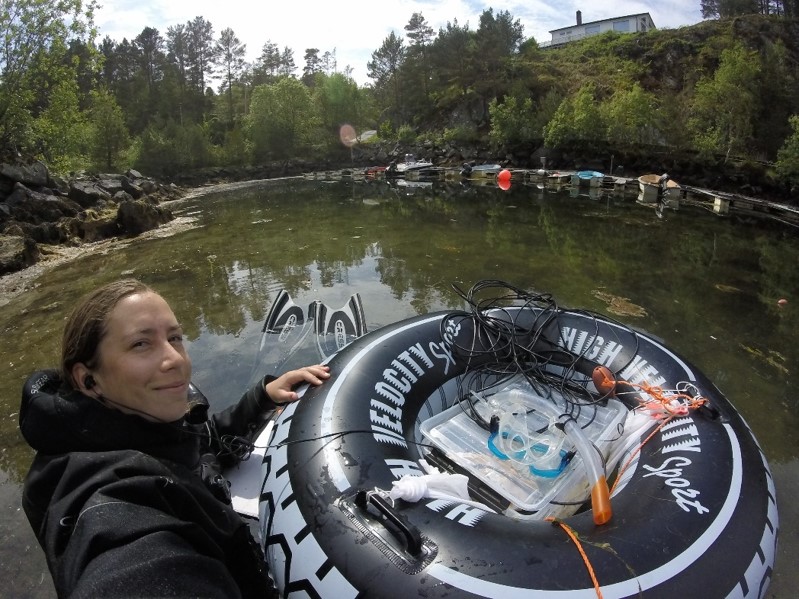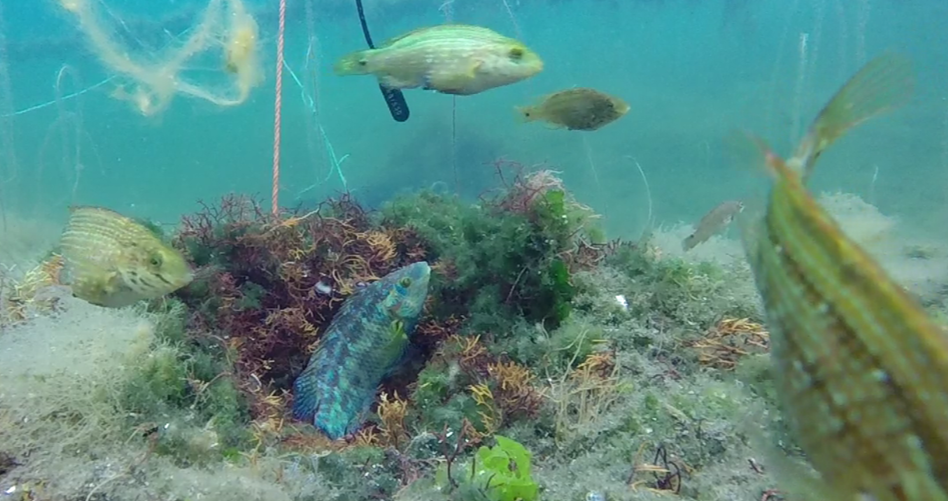Grunt, click and plop: The language of the corkwing wrasse

Published: 28.01.2021
This colourful wrasse is not only great to look at. It also has a fascinating behaviour, which has many similarities with birds.
The male corkwing wrasse builds a nest. He stuffs and weaves together a nest of selected pieces of seaweed. When the nest building is finished, the male’s focus changes from house building to mating - preferably with several females, as he has room for many eggs in his nest.
When his nest is filled with eggs, his focus changes to childcare. In that way he is a modern man.
Not only does he build a nest and care for the eggs – the corkwing wrasse also “sings”. Some of the sounds are so loud that you can even hear them above water, for example when sitting near the waterfront on a jetty or at the rocky shore in spring and summer. The sound you hear is a bit like someone clicking with their tongue.
In Austevoll, an archipelago on the west coast of Norway, its local trivial name is “Helle-klakk”. In Norwegian “helle” stands for rocky shores and “klakk” means to click or clap. So, the people at Austevoll have known for generations that it is the corkwing wrasse that makes this clicking sound! But the phenomenon has been unexplored by science.
Until 2016, when a Hjort scholarship gave us three the opportunity to study the corkwing wrasses' fascinating behaviour and sounds in the realm of the “helle-klakk", Austevoll. “Us three” – that is: Karen Bussmann, Germany, Karen de Jong, Netherlands and Anne Christine Utne Palm, Norway. We came together from three countries, unified by the fascination and passion for fish and underwater sounds, and we were eager to shed light on the Austevoll indigenous knowledge of the fish that “clicks on the rocks”.
Recently, the results of our study were published in the scientific journal Bioacoustics.

What we wanted to find out
We wanted to find out if it was the corkwing wrasse that make this clicking sound? - and if that was the case, if it makes other sounds, too? Only few scientists have studied the sounds of female fish - so we also wanted to investigate whether the females make sound? - and whether the female sounds differ from the male sounds? Furthermore, we wanted to find out in what contexts they used the sounds. Could we maybe find a connection between behaviour and sound?
We studied the corkwing wrasse in Haukanesvågen in Austevoll in the summer of 2016. There, we observed the corkwing wrasse's sounds and movements, by setting up video cameras and under-water microphones in front of the nests of corkwing wrasses.
The study showed that corkwing wrasses make as many as 4 different sounds: clicks, plops, grunts, and deep grunts.
Each of the sounds was found to be connected to a particular type of behaviour.
- Clicks and plops were made by both males and females. They were mainly used to chase away other corkwing wrasses or other animals, such as crabs or fish, which tried to steal eggs or just came too close to the nest.
- Grunts seems to be used by both males and females, to attract a potential mate’s attention. We saw that females approached a nest, grunted and then swam away quickly. The nest holding male then usually followed the female, and this often led to spawning.
- Only males made deep grunts, and they did so just before the female laid her eggs in the nest. Possibly it is the male's way of signalling to the female that he is ready to spawn.
- Both sexes make the same type of sounds, but in a slightly different way. Therefore, the corkwing might be able to hear whether it is a female or a male who makes the sound.
- Males and females sometimes grunted at each other while they followed each other around the nest. Such a mutual sound exchange indicates that they have a form of sound communication or language.

Why is this important to know?
Human activity adds a lot of noise pollution to the ocean. There are boat engines, dredging, oil exploration (seismic shooting), wind turbines and other marine activities, which are all producing noise. This man-made noise can overshadow the natural sounds of the ocean: the sound of a specific habitat like sound of waves crashing against rocks or sand, the sound of an estuary; the sound of a predator approaching; the sound of a swarm of food; the sound of a calling mate ready to spawn.
All these sounds can be important for an individual's survival and mating success – and therefore transmission of genes.
It is therefore important to find out which sounds fish and other marine organisms produce, the strength and intensity of the sounds, and what they use the sounds for. Gaining this type of knowledge gives us a better understanding of how man-made noise can affect marine species and marine ecology.
Therefore, we also examined the effect of man-made noise on the corkwing wrasses' spawning behaviour. We hope to have these results published soon. To investigate the effects of noise on corkwing wrasses, mapping the sounds they produce was a crucial first step. But only if we understand the effects of noise on their behaviour and communication, we can protect the corkwing wrasses and other fish, and make sure that they will still “click on the rocks” in the future.
